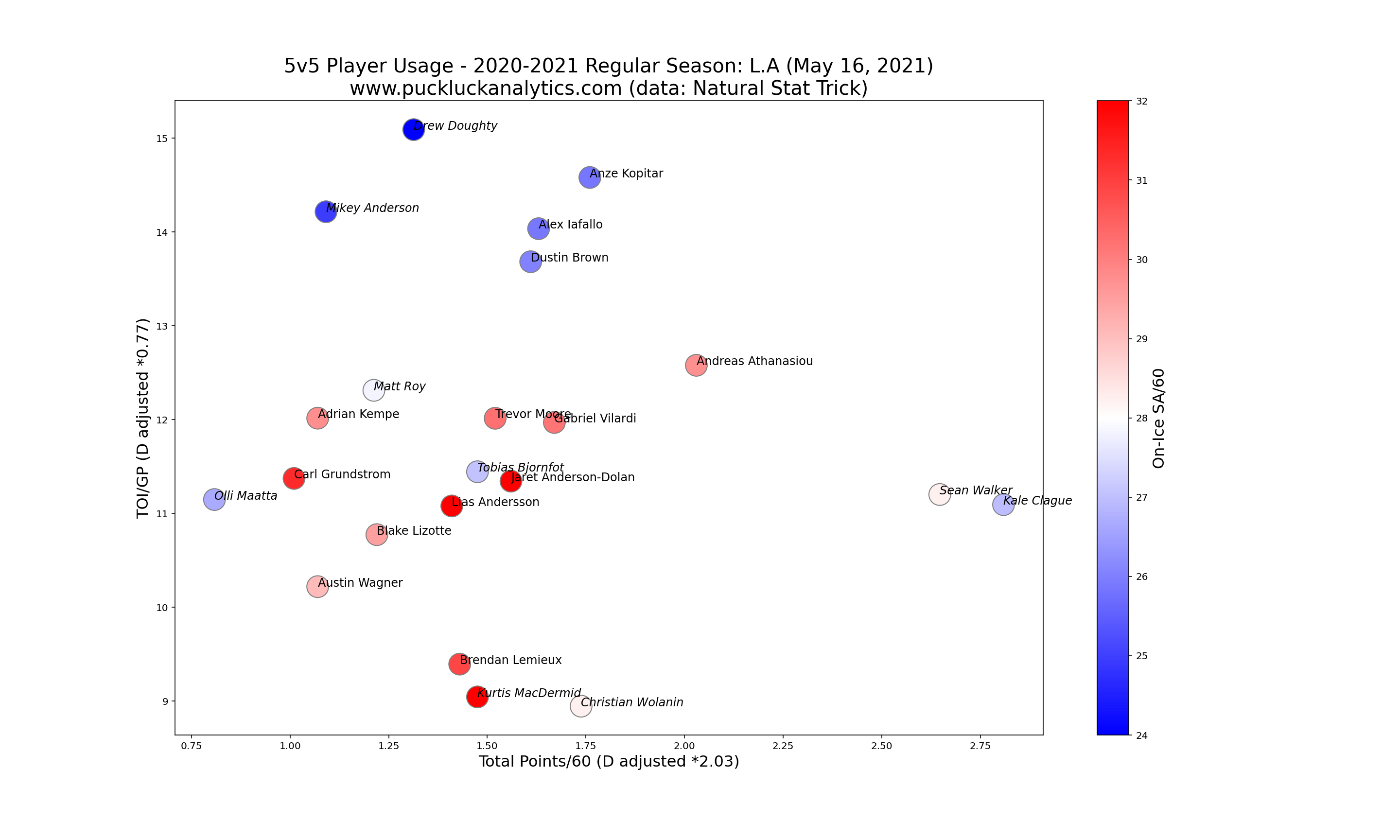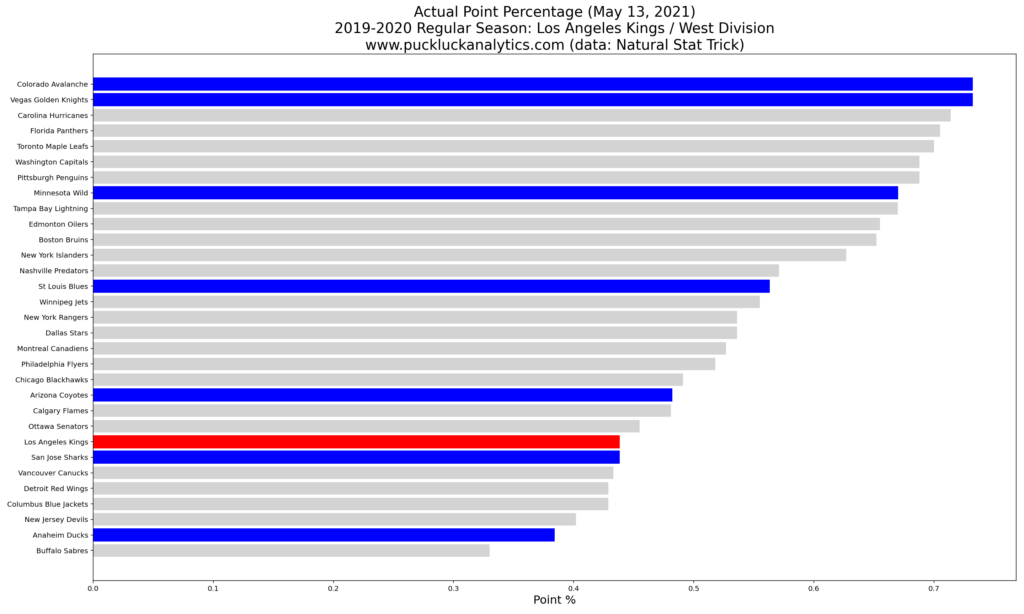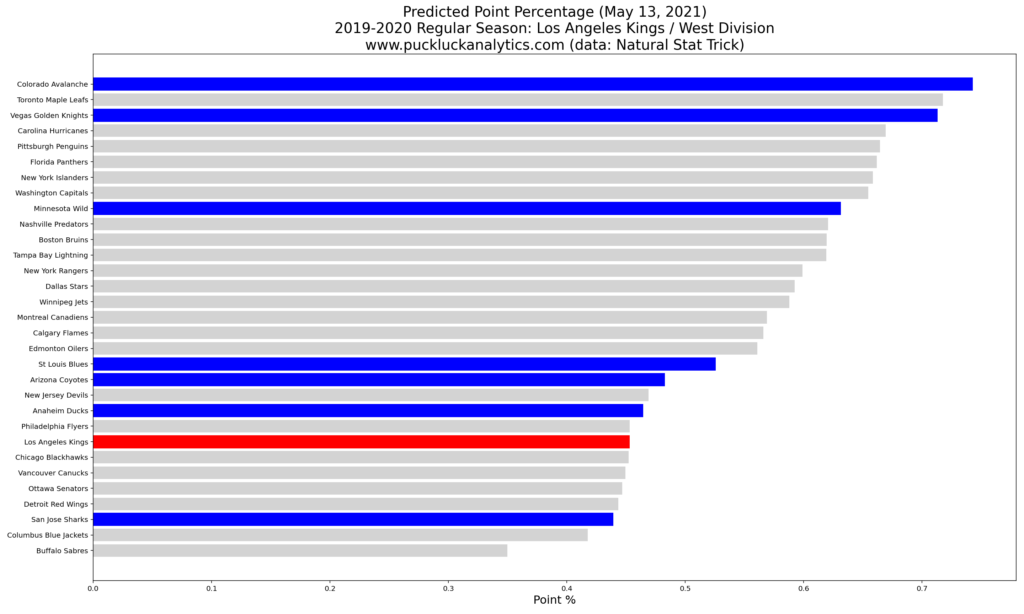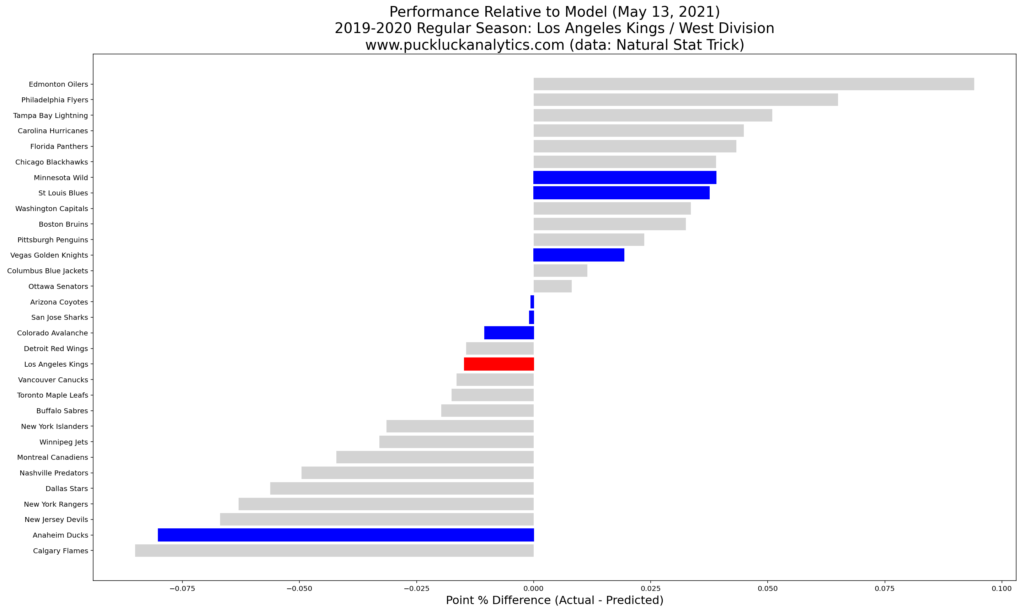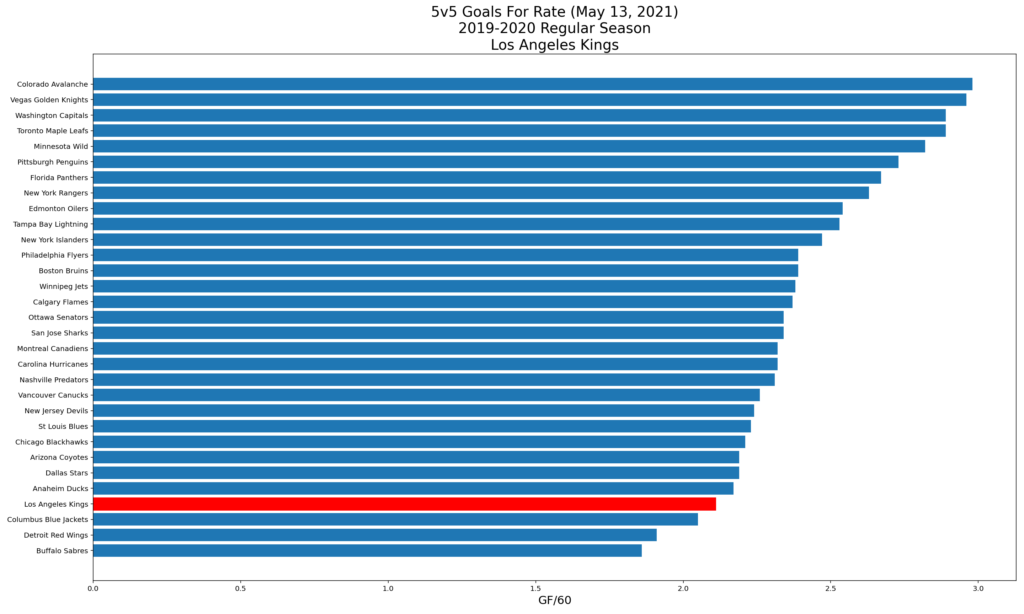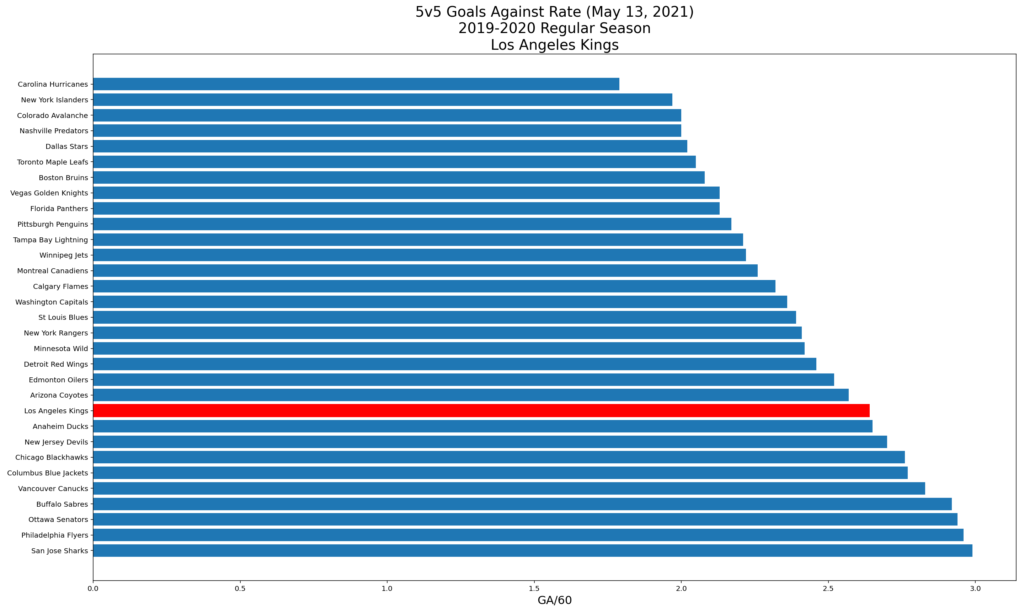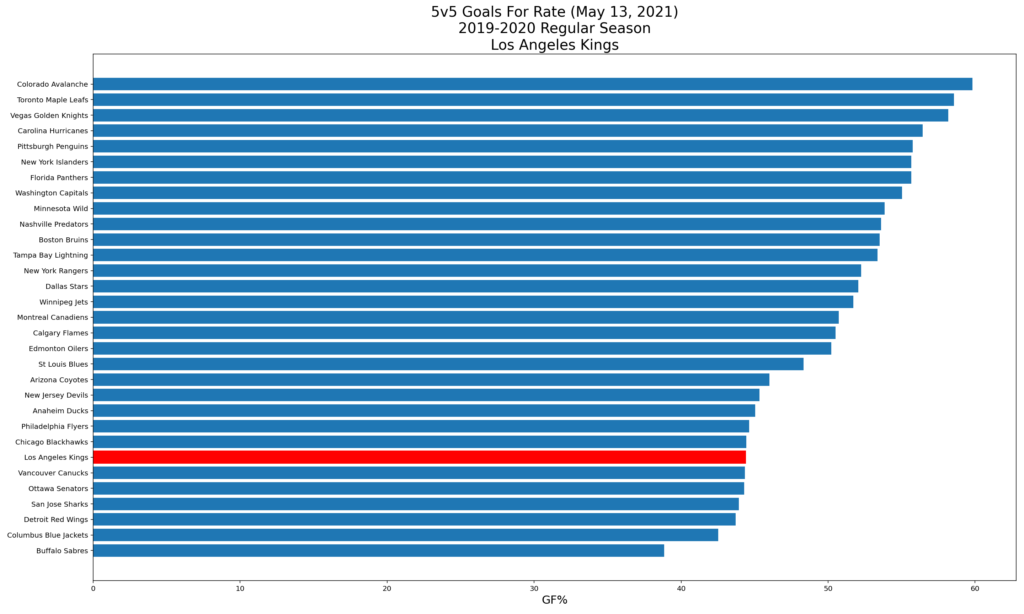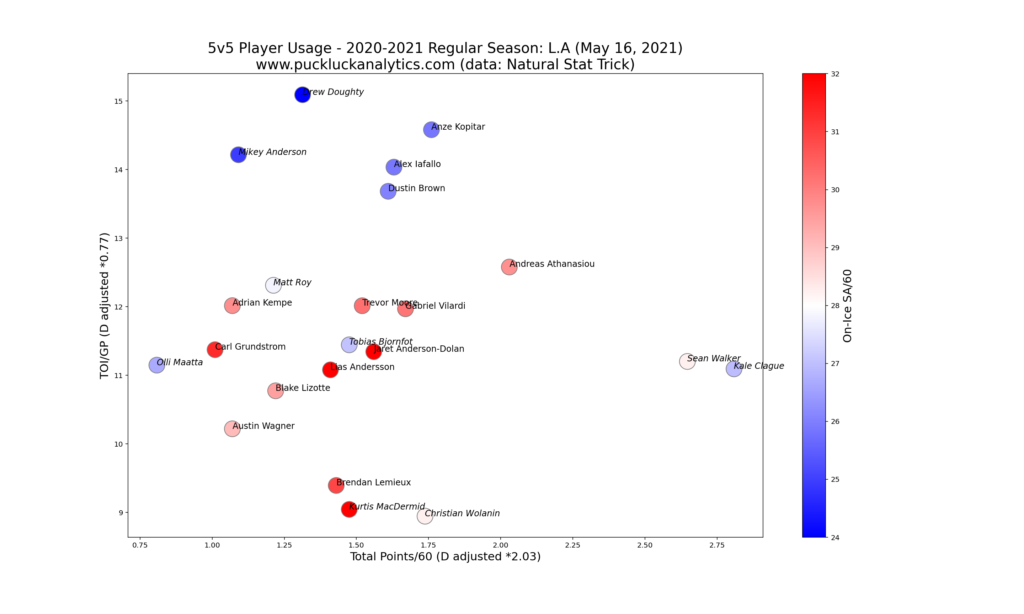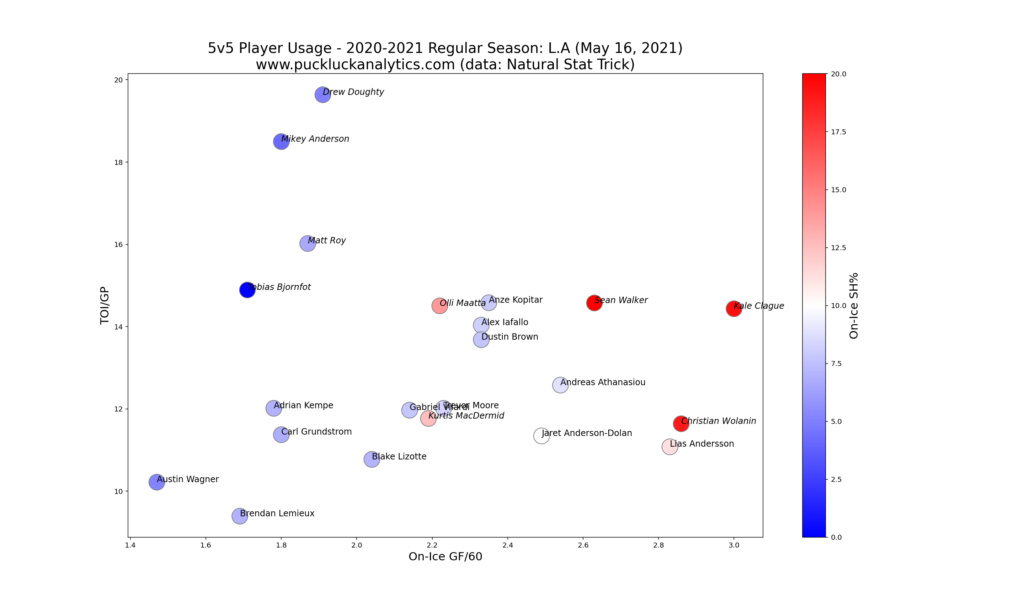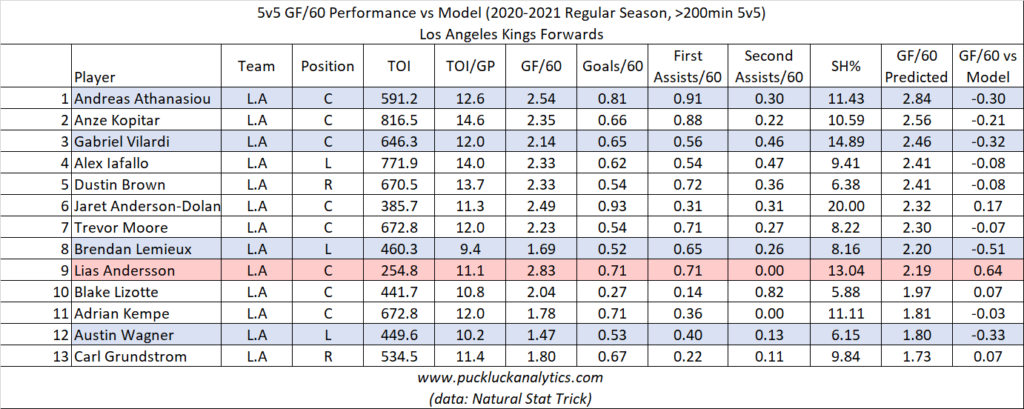During the Kings’ end of season interviews, Drew Doughty expressed a desire for management to be aggressive this offseason to bring in some key pieces that would turn the Kings back into a playoff contender. Are the Kings really just a few key pieces away? We’ll dig into this question in today’s review of the Kings’ 2020-2021 season. This post provides some additional detail on what I look for in the plots and I encourage you to check it out for a better understanding of the review.
Overall Performance
The Kings finished as the top team in California, but a lowly 6th in the West Division. Looking at the output from our point predictor model, we see the Anaheim Ducks leapfrog LA and San Jose. With the Kings’ actual point percentage quite near the model prediction, this is more a reflection of the Ducks underperforming than on the Kings.
With the model putting the Kings in 7th in the division, there may be more ground to cover than initially expected for the Kings to become a playoff team. Since the model focuses on 5v5 data as input, let’s dig into the Kings’ numbers further.
We see here that the Kings’ biggest struggle is scoring goals. With the 4th worst 5v5 offense in the league, they clearly need to improve this aspect of their game. Their defense is a bit better, but is still in the bottom third of the league at 5v5. The Kings have some all-around improvement required to get back in the playoffs.
Player Performance
To start breaking down player performance, we’ll look at a player usage chart for 5v5 play with defensemen’s stats scaled for comparison with forwards. This give us a visual depth chart on the diagonal starting from the top right.
There are a couple of things that stand out here. First, we don’t see the players distributed along a diagonal from top right to bottom left. This indicates that players were not utilized as effectively as possible. It appears that established veterans, like Drew Doughty, Anze Kopitar and Dustin Brown were significantly over-utilized based on their individual point production. There are also a couple of younger defensemen in Sean Walker and Cale Klague that appear to be significantly under-utilized.
The second thing that stands out is that there are no players in the top right section of the graph, where we would normally expect the team’s top players. This is a bit of a startling revelation. It seems that either the Kings still expect their aging veterans to produce as elite players or that they really don’t have another option. Either way, this looks like a big hole in the roster.
Let’s take a look at offensive production by plotting GF/60 vs TOI/GP. This gives us a visual indication of each player’s relative contribution to team GF/60.
Again, the biggest takeaway here is that the Kings veterans are no longer producing at elite levels. We don’t see them with the largest impacts, although some are still receiving the largest shares of 5v5 ice time.
Let’s take a similar look at relative contributions to team GA/60. We can use SA/60 vs TOI/GP for this, which gives us the relative contributions of skaters. Skaters contribute about 50% of the overall defensive impact (goaltenders the other 50%).
Here we see why the Kings veterans are being leaned on so heavily. They are having the largest individual impacts on team defense. However, with skater impacts only 50% toward overall defense and 100% toward overall offense, it’s clear that the Kings are still missing some top end talent.
Let’s take a look at our on-ice GF/60 models to see if there are any candidates to have breakout seasons given the right opportunity that may be able to fill some of the void at the top of the Kings’ roster. Generally, we are looking for variances between model and actual of greater than 0.25 to be significant. Negative variances suggest a player is carrying his line mates, positive variances the opposite.
With the highest predicted on-ice GF/60 at 5v5, Andreas Athanasiou stands out in the model results as one of the players who appears to have been carrying his line mates offensively. Looking back at our initial usage chart, we see he is on his own at the top end of the chart so it seems likely that he was a key offensive driver. Gabe Vilardi has similar results from the model and we see him near the top of the usage chart as well. Acquired from the Rangers mid-season, Brendan Lemieux also looks like he should be given a larger opportunity. With the lack of high end talent that it appears the Kings suffer from, adding some players to complement these three forwards would certainly help increase their impact.
Among the Kings’ defensemen, we see Tobias Bjornfot and Mickey Anderson stand out as players who had a significant positive effect on their line mates offensively and Christian Wolanin as the D-man who was carried by others. In Wolanin’s case, this may not be very telling since we’ve included his full season combined stats from Ottawa and LA this season. What is more interesting here is that the majority of the Kings’ defensemen have negative variances. This points to the forwards as the primary issue offensively, suggesting that the forwards were holding back the offense regardless of which defensemen were on the ice.
In net, Cal Peterson provided quality goaltending and looks to have established himself as the Kings starter. Jonathan Quick has been relegated to backup duties and his performance was sub-par even in that role this season. The Kings need a better performance from him to help improve their overall defensive numbers.
Looking Ahead
The Kings have $61M committed to the 2021-2022 cap as they head into the offseason. They have some room to bring in players to fill some of their holes, but it may not be enough to make them competitive.
Key RFAs:
Athanasiou is the Kings most important RFA this offseason. We saw he was an offensive leader for the Kings this season in our review. While he probably shouldn’t be counted on to be a franchise cornerstone, the Kings would do well to surround him with some better line mates to maximize his impact.
Christian Wolanin is a 26 year old RFA. While we saw that the Kings’ defensemen generally held up the Kings offense, that wasn’t true of Wolanin. However, being acquired from Ottawa mid-season this may misleading. The Kings should do a deeper dive before deciding how to handle Wolanin’s contract.
Key UFAs:
The Kings have no players headed for unrestricted free agency that finished the season on the NHL roster or taxi squad.
Key Players Under Contract:
The Kings big three veterans will be key to the Kings success next season. Kopitar (33), Brown (36) and Doughty (31) have a combined cap hit of almost $27M. We saw that they were still leaned on heavily in terms of ice time this season, despite rather poor offensive numbers. They need to produce more and the Kings need to bring in some additional top end talent to complement them.
Tough Questions:
Given the gaping hole at the top of the lineup, can the Kings add enough top end talent in one offseason to become a playoff team again? There don’t appear to be a lot of young players in the organization with high potential to fill big roles next season, so the holes would have to be filled via free agency or trade. LA has been rumored to be interested in Jack Eichel but they will have to relinquish some assets to net him and they would likely still need to add 2-3 more top six forwards and possibly a top 4 defenseman.
Offseason Priority:
The Kings are missing too many pieces to become a contender with one aggressive offseason. They don’t seem to have a clear group of young players to build around for a contention window. Their best option this offseason looks to be planning for a rebuild, identifying their target window to contend, and start offloading players that don’t fit with those plans.
Check out my other season reviews that are already up, such as the San Jose Sharks and Anaheim Ducks, and subscribe to see the rest of my season reviews as they come out.
data: Natural Stat Trick
cap data: CapFriendly
